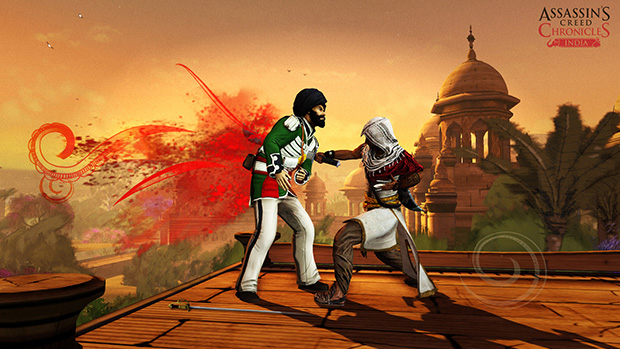Exploring in Assassin’s Creed Chronicles: India
Assassin’s Creed Chronicles is an exciting direction for Ubisoft’s stealth-action series for plenty of reasons. The new side-scrolling perspective and bite-sized action segments deliver a welcome twist on the typical sneaking, stalking, and stabbing that we’ve all come to expect from the franchise over the past decade.
Just as exciting, however? Assassin’s Creed Chronicles’ trio of intriguing settings promise to make these adventures feel like nothing any would-be Assassin has played before. This three-part saga features three vast nations that have seen immensely important roles in world history but haven’t played a significant part in Assassin’s Creed – until now. The history-hopping series is all about putting a lens on some of the most famous names and places, and perhaps no three countries on the planet deserve that spotlight like China, India, and Russia.
Today, we’ll look at the landscape of Assassin’s Creed Chronicles: India (which landed on Xbox One and Windows PC last week), and see what’s in store for Assassin protagonist Arbaaz Mir as he navigates some of the most eye-popping scenery in franchise history in a 2.5D platforming adventure. Arbaaz was originally introduced in the 2013 graphic novel “Assassin’s Creed: Brahman,” so that should provide some background on the man himself.
India is a far more complex creature, though. It’s packed with thousands upon thousands of years of history and an astoundingly diverse set of peoples, so let’s drill down and take a look at the specific landscape of Assassin’s Creed Chronicles: India, which takes place near the modern-day border of modern-day India and Pakistan in Punjab, otherwise known as the Land of Five Rivers – and a pivotal crossroads throughout history. This corner of the country features some of the most picturesque locales in all of India, so it’s a fitting place for the stunning visuals on display here.
When the events of Assassin’s Creed Chronicles: India unfold, Punjab is the home of the Sikh Empire. In fact, while it’s home to Amritsar, the holiest of cities in the Sikh religion, Arbaaz himself is a Muslim from Kashmir to the north… so he’s a bit of an outsider. As always seems to be the case in Assassin’s Creed, there’s somewhat of a clash of faiths – Hinduism and Buddhism are present as well – to go along with the clash of the Assassins and Templars. And that extends to Arbaaz’s love, a Sikh beauty named Pyara Kaur who’s the daughter of Kharat Singh, a figure who actually existed in history as the second ruler of the Sikh Empire.
The big showdown here, however, is between the Sikh Empire and the East India Company, the powerful organization that monopolized trade in the region for centuries and ruled over with the Indian Subcontinent with the help of private armies. But make no mistake: Even though India isn’t officially under control of the crown of Queen Victoria, British influence – not to mention troops – are everywhere.
And there’s a reason for their presence. It turns out that the British Templars are after the gorgeous Koh-i-Noor diamond, a Piece of Eden in Assassin’s Creed lore. Today, the real-life Koh-i-Noor is among the British Crown Jewels, so if you take a trip to the Tower of London, you can take a look at it and the other precious gems acquired by the British Empire over the years (as Assassin’s Creed would tell us, the Koh-i-Noor on display at the Tower of London is a mere replica, but trust us – it’s the genuine article in our reality, and well worth the trip).
Besides the historical backdrop, Assassin’s Creed Chronicles: India also provides plenty of other reasons to explore its stunning landscapes. Several iconic animals from the Subcontinent are present and accounted for, including gorgeous elephants decked out in war paint. And when Arbaaz takes a leap of faith, he’ll do it against some of the most spectacular architecture the series has seen to date.
Where all this will go in Assassin’s Creed Chronicles: India remains a tantalizing enigma, but we do know that the First Anglo-Sikh War will break out four years after the events of the game… so whatever Arbaaz’s adventures have in store, it won’t exactly bring peace to the region.
Of course, like any good Assassin, he’s prepared for combat wherever it comes, and he’s appropriately armed with a talwar sword, the famous curved blade that spread through India under the rule of the Mughal Empire (they’re the ones who built the Taj Mahal, to give a frame of reference) and had become ubiquitous in the Subcontinent by the mid-19th century. He’s also got a projectile option in the chakram, a circular throwing weapon native to India – so ancient and entwined with the history of the country, in fact, that it’s referenced in India’s two famous epic poems, the “Mahabharata” and “Ramayana.” Finally, like any Assassin, Arbaaz wields a hidden blade. Naturally, his has a bit of twist: It’s a trident that splits into three. That doesn’t appear to have any basis in historical Indian weaponry, but it sure looks cool!
So as you can see, Arbaaz Mir’s adventure in the Sikh Empire is hardly a minor side story. It’s a landmark crossroads in world history that came to define the colonial conflicts of the 19th century – and it’s a fitting backdrop for the intrigue of Assassin’s Creed. If you’re interested in taking a look for yourself, be sure to download Assassin’s Creed Chronicles: India, available now for Xbox One and Windows PC.

